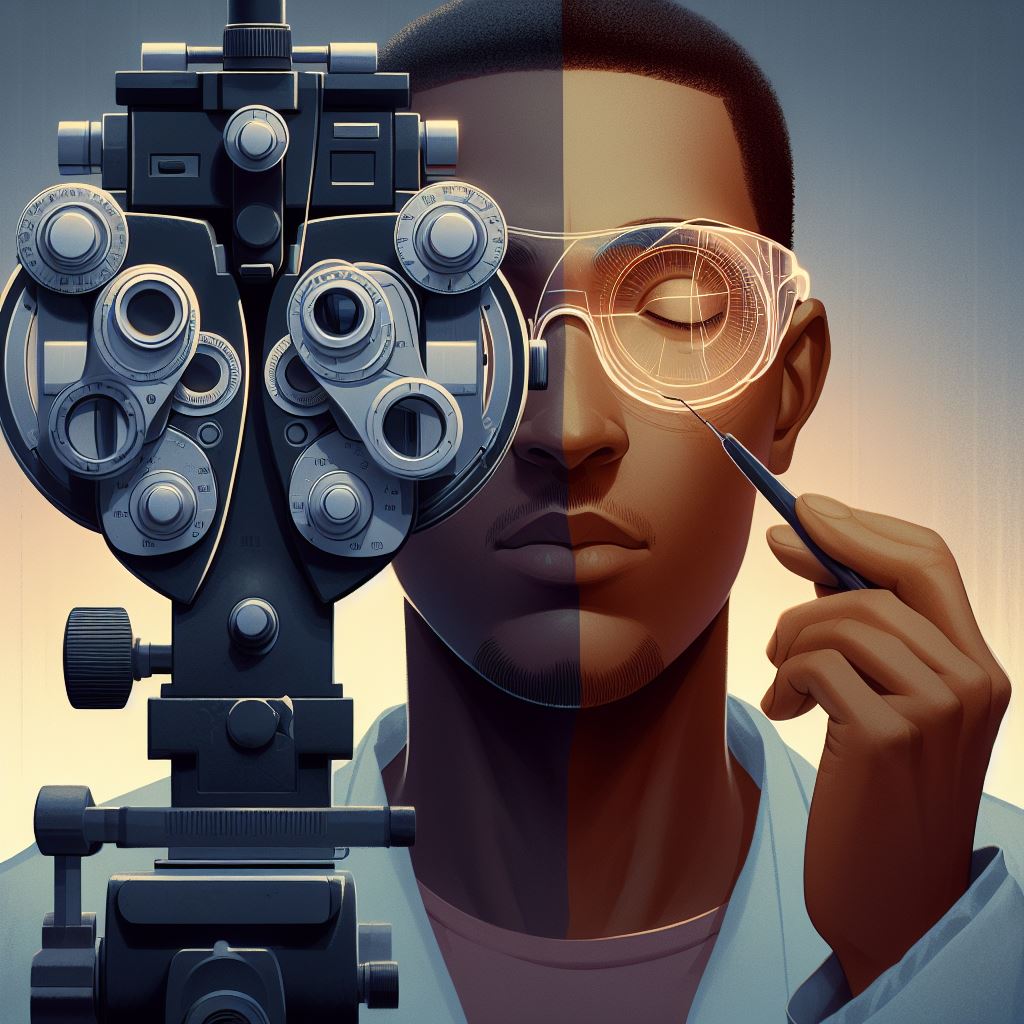Introduction
Building a portfolio as a holography technician in Nigeria is crucial for career advancement. It showcases skills, experience, and accomplishments.
Benefits and Purpose of Creating a Comprehensive Portfolio
A comprehensive portfolio demonstrates competence, expertise, and professionalism in the holography field.
It serves as evidence of one’s abilities, helping to secure job opportunities and attract clients.
By showcasing successful projects, it highlights problem-solving skills and creativity, increasing credibility and trustworthiness.
A portfolio enables employers and clients to assess skills and suitability for specific holography projects.
It provides a visual representation of the technician’s capabilities, allowing potential clients to make informed decisions.
Additionally, a well-curated portfolio helps technicians differentiate themselves from competitors in a crowded job market.
Furthermore, portfolios act as a self-assessment tool, enabling technicians to review and improve their own skills.
Creating a strong portfolio involves selecting the most relevant and impressive holography projects.
Technicians should include detailed project descriptions, highlighting their contributions and achievements.
The portfolio should be visually appealing, presenting images and videos of completed projects.
It is important to regularly update the portfolio with new projects and accomplishments to reflect growth and ongoing development.
Building a portfolio as a holography technician in Nigeria is crucial for professional growth and success.
A comprehensive portfolio offers numerous benefits, such as attracting clients, securing job opportunities, and showcasing skills.
Understanding the Role of a Holography Technician in Nigeria
A holography technician in Nigeria is responsible for operating and maintaining holographic equipment.
Job Description of a Holography Technician in Nigeria
- Operating holographic equipment for the creation of three-dimensional holograms.
- Maintaining and troubleshooting holographic equipment to ensure optimal performance.
- Developing and implementing holographic techniques to meet various industry requirements.
- Collaborating with clients to understand their holographic display needs and executing them accordingly.
- Creating and editing holographic content using specialized software and equipment.
- Ensuring the quality control of holographic products by conducting regular inspections.
- Keeping up-to-date with the latest advancements in holographic technology to enhance skills and knowledge.
Holography technology has witnessed a significant surge in demand in various industries in Nigeria.
Increasing Demand for Holography Technology in Various Industries
- The manufacturing industry utilizes holographic technology for product labeling and authentication to combat counterfeiting.
- The entertainment industry employs holography for live performances and virtual reality experiences.
- The education sector uses holographic displays for interactive learning and visualization of complex topics.
- In the healthcare industry, holography assists in medical training, surgical planning, and telemedicine.
- Holograms are also employed in the advertising industry for captivating and attention-grabbing campaigns.
- The security sector relies on holography for ID cards, passports, and banknotes to prevent forgery and fraud.
- Holographic technology is increasingly used in architecture and construction for visualizing building designs.
- The retail industry utilizes holography for product demonstrations, enhancing customer experiences.
The holography technician plays a vital role in meeting the growing demand for holography technology.
To become a successful holography technician in Nigeria, one must possess a combination of technical skills and creativity.
Essential Skills for a Holography Technician in Nigeria
- Proficiency in operating holographic equipment and understanding its technical aspects.
- Knowledge of holographic software to design and edit holographic content.
- Strong troubleshooting abilities to identify and resolve technical issues.
- Attention to detail to ensure the quality and accuracy of holographic displays.
- Excellent communication skills to collaborate with clients and understand their requirements.
- Continuous learning to keep up with technological advancements in holography.
- Creativity to develop innovative holographic techniques and displays.
- Adaptability to work in diverse industries and adapt to their holographic needs.
Building a strong portfolio as a holography technician is crucial to showcase skills and attract potential clients.
Tips for Building an Impressive Holography Technician Portfolio in Nigeria
- Create a diverse range of holographic displays to demonstrate versatility.
- Include before-and-after examples to showcase improvement and growth in holographic techniques.
- Add testimonials from satisfied clients to build credibility and trust.
- Showcase any awards, recognition, or certifications related to holography technology.
- Regularly update the portfolio with new and unique holographic projects.
- Promote the portfolio through online platforms and social media to reach a wider audience.
- Collaborate with other professionals in the industry to expand skillsets and network.
- Seek feedback from mentors or experienced holography technicians to improve the portfolio.
Most importantly, a holography technician in Nigeria plays a crucial role in meeting the increasing demand for holography technology across various industries.
With a combination of technical skills, creativity, and a strong portfolio, one can excel in this field and contribute to the advancement of holography in Nigeria.
Importance of a Portfolio in the Holography Industry
When it comes to building a career as a Holography Technician in Nigeria, having a strong portfolio is essential.
A portfolio is a collection of your best work that showcases your skills, experience, and creativity to potential employers.
In this section, we will highlight the significance of a portfolio in the holography industry and how it can open up employment opportunities.
Highlighting the Significance of a Portfolio
- A portfolio serves as visual evidence of your abilities and achievements.
- It provides employers with a quick and efficient way to evaluate your potential.
- A well-curated portfolio can make you stand out from other candidates.
- Employers often request portfolios as a prerequisite for job interviews or applications.
- A portfolio demonstrates your commitment to your craft and showcases your professional growth.
Showcasing Skills, Experience, and Creativity
Building a portfolio goes beyond simply collecting samples of your work.
It allows you to showcase your skills, experience, and creativity in a visually appealing and organized manner.
Here’s how:
Skills
- Include examples of holography projects that highlight your technical skills and expertise.
- Demonstrate your proficiency in holographic techniques, image processing, and software applications.
- Show how you can finely manipulate light to create 3D holographic images.
Experience
- Include projects you have worked on, both independently and as part of a team.
- Showcase a variety of holography applications, such as security holograms, holographic displays, or holographic art.
- Provide details about your role in each project and the challenges you faced.
Creativity
- Include samples that demonstrate your ability to think outside of the box.
- Showcase holographic designs that are visually striking and innovative.
- Experiment with different holographic techniques to create unique and captivating visuals.
In addition to displaying your work, your portfolio should also include a brief description of each project, outlining the objectives, techniques used, and any notable achievements.
This context helps employers understand the depth of your involvement and the impact of your work.
A portfolio can be a physical collection of prints or a digital presentation. Whichever format you choose, ensure that your portfolio is well-organized, visually engaging, and easy to navigate.
It should effectively communicate your skills, experience, and creativity to potential employers.
Finally, regularly update your portfolio to reflect your most recent work and skills. As a holography technician, you must keep up with the latest advancements in technology and techniques.
Updating your portfolio shows that you are proactive and committed to staying relevant in the industry.
In essence, a strong portfolio is crucial for success in the holography industry in Nigeria.
It serves as evidence of your skills, experience, and creativity, and can greatly enhance your chances of securing employment opportunities.
So invest the time and effort to build a portfolio that truly represents your abilities and opens doors to a fulfilling career as a Holography Technician.
Read: Networking for Holography Professionals in Nigeria: How-To

Building Your Portfolio as a Holography Technician
Building a strong and impressive portfolio is essential for success as a holography technician in Nigeria.
A portfolio showcases your skills, experience, and creativity, allowing potential employers or clients to assess your competence and suitability for their projects.
In this section, we will explore the key elements of building a comprehensive and impactful portfolio.
Prioritize Skill Development
To become a successful holography technician, it is crucial to identify and prioritize the essential skills required in the field.
These may include knowledge of holographic technology, laser physics, image processing, and design software.
Continuous learning and improvement are vital to stay updated with the latest advancements and industry trends.
Actively seek opportunities to enhance your skills through workshops, online courses, or industry conferences.
Documenting Education and Certifications
Including your educational background and relevant certifications in your portfolio is essential to provide credibility and demonstrate your competence as a holography technician.
Clearly list your educational qualifications, highlighting any specialization or research projects related to holography.
Additionally, add details about any certifications you have obtained, such as Certified Holography Technician, which can enhance your professional standing.
Showcasing Practical Experience
Practical experience is highly valued in the holography industry. Include work samples, projects, and case studies that showcase your abilities and achievements.
Highlight projects where you have successfully designed and produced holograms, demonstrating your technical skills and problem-solving abilities.
Consider including a brief description of each project, explaining your role and the impact it had.
Demonstrating Creativity and Innovation
In the rapidly evolving field of holography, creativity and innovation play a critical role. Include examples of creative holography projects that demonstrate your ability to think outside the box and push the boundaries of traditional holography.
Showcase projects that involve unconventional ideas or experimental techniques, showcasing your unique perspective and creative problem-solving skills.
In fact, building a portfolio as a holography technician requires a strategic approach.
Prioritizing skill development, documenting education and certifications, showcasing practical experience, and demonstrating creativity and innovation are key elements that will help you stand out in the Nigerian holography industry.
Remember to regularly update and refine your portfolio to reflect your growth and latest accomplishments.
Your portfolio serves as a powerful tool to impress potential employers or clients and secure exciting opportunities in the holography field.
Read: Women in Optics and Holography in Nigeria: A Close Look
Designing a Professional Holography Portfolio
Designing a professional holography portfolio plays a crucial role in presenting your skills and expertise as a holography technician in Nigeria.
Your portfolio serves as a showcase of your abilities, making it essential to invest time and effort in designing it effectively.
This section will guide you through the process of creating a captivating holography portfolio that attracts clients and highlights your achievements.
Choosing the Right Platform
When building your holography portfolio, you have the option to select either a digital or physical platform for hosting.
Digital platforms, such as personal websites, online portfolios, or social media platforms, provide worldwide accessibility and allow potential clients to easily access your work.
On the other hand, physical platforms, like printed portfolios or a gallery exhibition, offer a tangible and tactile experience for viewers.
Consider the pros and cons of each platform option based on your target audience and resources before making a decision.
Organizing Portfolio Content
To create an engaging experience for viewers, it is crucial to structure your holography portfolio thoughtfully.
Consider organizing your work chronologically, categorically, or by specific projects.
This enables viewers to navigate through your portfolio seamlessly and understand the evolution of your skills and expertise.
Additionally, clear navigation and categorization ensure that visitors can find what they are looking for easily, enhancing their overall experience.
Presenting Visuals and Media
Visual elements are fundamental in a holography portfolio. High-quality images and videos effectively capture the attention of potential clients and showcase your capabilities.
Invest in professional photography or videography to ensure your holography projects are accurately portrayed. Select visuals that align with the type of work you excel at and showcase your technical prowess.
Remember, a picture is worth a thousand words, so choose visuals that effectively communicate your skills and professionalism.
Adding Accomplishments and Testimonials
To further enhance your holography portfolio, include any accomplishments, awards, or recognition you have received as a holography technician.
This demonstrates your expertise and establishes credibility with potential clients.
Additionally, positive testimonials from satisfied clients or colleagues can boost your portfolio’s credibility and provide social proof of your skills and professionalism.
In general, designing a professional holography portfolio requires careful consideration of the platform, organization of content, presentation of visuals and media, and inclusion of accomplishments and testimonials.
By following these guidelines, you can create a portfolio that effectively showcases your holography skills and attracts potential clients in Nigeria.
Read: Work-Life Balance for Optics Technicians in Nigeria: A Study
Promoting Your Holography Portfolio
Effective self-promotion is crucial for career advancement as a holography technician in Nigeria.
By effectively promoting your portfolio, you can gain exposure, attract potential clients or employers, and establish yourself as a reputable professional in the industry.
Here are some tips on how to promote your holography portfolio:
Understand the Importance of Self-Promotion
- Showcasing your work through self-promotion helps you stand out from the competition.
- It allows you to demonstrate your skills, creativity, and expertise to potential clients or employers.
- Self-promotion helps build a strong professional network and fosters collaborations with other industry professionals.
Leverage Social Media Platforms
- Create a professional online presence on platforms like Instagram, Facebook, LinkedIn, and Twitter.
- Regularly update your social media profiles with high-quality images and videos of your holography projects.
- Engage with your audience by sharing insights, behind-the-scenes stories, and answering questions.
- Use appropriate hashtags to improve the visibility of your posts and attract relevant followers.
- Collaborate with influencers, bloggers, or businesses related to holography to expand your reach.
Attend Networking Events
- Participate in industry-specific events, conferences, and exhibitions to connect with potential clients or employers.
- Prepare an elevator pitch to effectively introduce yourself and your holography portfolio.
- Carry business cards or brochures with your contact information and website, making it easy for people to reach you.
- Engage in meaningful conversations, ask questions, and listen actively to expand your professional network.
Collaborate and Network with Other Professionals
- Reach out to other holography technicians or professionals in related fields for potential collaborations.
- Consider cross-promotion opportunities by featuring each other’s work on social media or websites.
- Attend workshops, seminars, or training sessions to meet like-minded individuals and exchange knowledge.
- Participate in online forums or communities to engage with experts and seek advice.
Maintain a Professional Website
- Create a visually appealing and user-friendly website to showcase your holography portfolio.
- Include a dedicated portfolio page with high-quality images or videos of your best holography projects.
- Provide a brief bio, your skills, qualifications, and contact information on your website.
- Regularly update your portfolio by adding new projects and removing outdated ones.
- Showcase client testimonials or positive feedback to establish trust and credibility.
By effectively promoting your holography portfolio through self-promotion, social media platforms, networking events, and collaborations, you can increase your visibility, attract potential clients or employers, and advance your career in Nigeria’s holography industry.
Read: Recent Advances in Holography: Nigeria’s Role & Contribution
Uncover the Details: Insider’s View: A Day in a Lagos Waiter’s Life
Conclusion
Building a portfolio as a holography technician in Nigeria is crucial. It showcases one’s skills, experience, and competency in the industry.
By having a strong portfolio, holography technicians can demonstrate their capabilities to potential employers and clients.
This gives them a competitive advantage and increases their chances of securing better job opportunities.
Furthermore, a portfolio allows technicians to document their projects and achievements, creating a visual representation of their work.
Publish Your Professional Profile, Business or Brand
Showcase your expertise, gain trust, and boost visibility instantly on Professions.ng.
Publish NowThis serves as a reference for future clients and builds credibility in the industry.
Additionally, having a portfolio shows dedication and commitment to professional growth.
It reflects a technician’s willingness to continuously improve their skills and stay up-to-date with the latest holography techniques and technologies.
Therefore, I encourage readers who aspire to become holography technicians in Nigeria to start creating their own portfolios.
This will not only allow them to showcase their talent and expertise but also enhance their career prospects in the holography industry.
So don’t wait any longer! Start collating your projects, documenting your achievements, and showcasing your skills through a comprehensive portfolio.
Your portfolio will be the key to unlocking exciting opportunities in the holography field.




